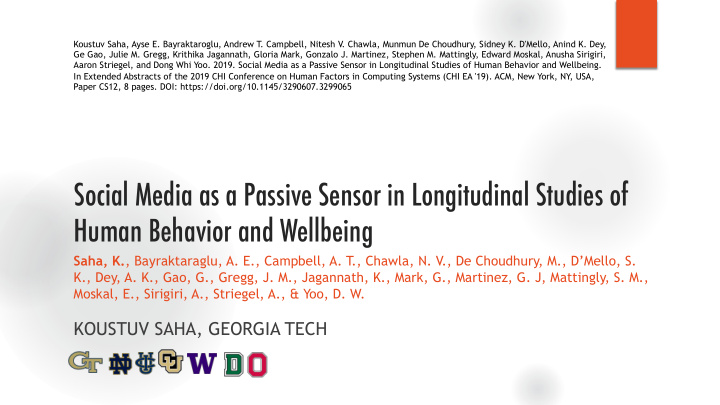



Koustuv Saha, Ayse E. Bayraktaroglu, Andrew T . Campbell, Nitesh V . Chawla, Munmun De Choudhury, Sidney K. D'Mello, Anind K. Dey, Ge Gao, Julie M. Gregg, Krithika Jagannath, Gloria Mark, Gonzalo J. Martinez, Stephen M. Mattingly, Edward Moskal, Anusha Sirigiri, Aaron Striegel, and Dong Whi Yoo. 2019. Social Media as a Passive Sensor in Longitudinal Studies of Human Behavior and Wellbeing. In Extended Abstracts of the 2019 CHI Conference on Human Factors in Computing Systems (CHI EA '19). ACM, New York, NY , USA, Paper CS12, 8 pages. DOI: https://doi.org/10.1145/3290607.3299065 Social Media as a Passive Sensor in Longitudinal Studies of Human Behavior and Wellbeing Saha, K. , Bayraktaraglu, A. E., Campbell, A. T ., Chawla, N. V., De Choudhury, M., D’Mello, S. K., Dey, A. K., Gao, G., Gregg, J. M., Jagannath, K., Mark, G., Martinez, G. J, Mattingly, S. M., Moskal, E., Sirigiri, A., Striegel, A., & Yoo, D. W. KOUSTUV SAHA, GEORGIA TECH
Sensing Human Survey Instruments Behavior • Self-Report Questionnaires Active Sensing • Ecological Momentary Assessments (EMAs) Passive Sensing • Smartphones and Wearables • Social Media
The Tesserae Project Wearable 757 Smartphone Participants BT Beacon Social Media By leveraging passive sensors, this study aims at proactively identifying changes in an Surveys individual that may impact their wellbeing and job performance
The Tesserae Project Wearable 757 Smartphone Participants BT Beacon Social Media By leveraging passive sensors, this study aims at proactively identifying changes in an Surveys individual that may impact their wellbeing and job performance
Social Media as a Passive Sensor u Naturalistic setting u Unobtrusive access Not always easy to collect u Longitudinal and Extended Periods (beyond study period) u Verbal and Behavioral
This case study… …introduces an infrastructural framework to illustrate the feasibility of collecting social media data at scale. This is in the context of an ongoing multimodal sensing study of workplace performance
Social Media Data Collection Infrastructure v Facebook , LinkedIn , Instagram, Twitter, GMail, Calendar v Open Authentication (OAuth) v Social Media Authorization per platform v Python Web application using Django framework v Models-Views-Controller (MVC Architecture) v Hosted on a secure and encrypted server
Tackling Developmental Challenges v Continuous development and testing with use-cases and automated scripts for debugging v API changes during ongoing data collection v Cambridge Analytica breach, and more comprehensive application approval
Facebook Data
Facebook Dataset: Participant Authorization Out of 757 participants (Facebook data): ● 587 participants consented and authorized ● 67 consented, did not authorize ● 103 did not have Facebook Account We did not collect photos, media and private messages
Who authorized Facebook Data? u Female participants more likely 80 Authorized to authorize than Males Not Authorized Percentage of Users No Account 60 u Male participants less likely to 40 have a Facebook Account 20 u No significant difference in authorization behavior across 0 Female Male age, income, personality trait Gender
Descriptive Statistics u 237,725 Timeline updates (Median: 195 per participant) 0 . 00035 u 1,672,482 Likes received (Median: 1,1,51 per 0 . 00030 Density (Updates) participant) 0 . 00025 0 . 00020 u 452,003 Comments received (Median: 331 per 0 . 00015 participant) 0 . 00010 u 1,917 days of data on an average per participant 0 . 00005 (October 2005 – August 2018) 0 . 00000 2005 2007 2010 2013 2016 2018 Date
Associating with Participant Attributes: Demographic 5000 *** 4000 3000 *** 2000 1000 0 Likes Received Comments Received Female Male *** p < .05
Associating with Participant Attributes: Personality u Higher agreeableness / extraversion / openness is associated with greater likes and comments received u Higher conscientiousness is associated with shorter posts u Higher neuroticism / openness is associated with longer posts
Associating with Participant Attributes: Wellbeing u Poorer sleep quality is associated with longer posts, more likes and more comments u Higher negative affect is associated with lesser likes received
Takeaways, Lessons, and Guidelines
An infrastructure to unobtrusively collect social media data at scale
Who agrees to share their social media data for research?
Observation: Differences in data with personality traits and wellbeing attributes
Recommendation: Control for gender in terms of social media data quantity
We share de-identified (and specially consented) sample of our dataset for research purposes
Koustuv Saha, Ayse E. Bayraktaroglu, Andrew T . Campbell, Nitesh V . Chawla, Munmun De Choudhury, Sidney K. D'Mello, Anind K. Dey, Ge Gao, Julie M. Gregg, Krithika Jagannath, Gloria Mark, Gonzalo J. Martinez, Stephen M. Mattingly, Edward Moskal, Anusha Sirigiri, Aaron Striegel, and Dong Whi Yoo. 2019. Social Media as a Passive Sensor in Longitudinal Studies of Human Behavior and Wellbeing. In Extended Abstracts of the 2019 CHI Conference on Human Factors in Computing Systems (CHI EA '19). ACM, New York, NY , USA, Paper CS12, 8 pages. DOI: https://doi.org/10.1145/3290607.3299065 Social Media as a Passive Sensor in Longitudinal Studies of Human Behavior and Wellbeing This research is supported in part by the Office of the Director of National Intelligence (ODNI), Intelligence Advanced Research Projects Activity (IARPA), via IARPA Contract No. 2017-17042800007. Thank You @kous2v| koustuv.saha@gatech.edu | koustuv.com
Recommend
More recommend